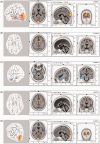Changes in brain activation during sedation induced by dexmedetomidine
- PMID: 28480811
- PMCID: PMC5536405
- DOI: 10.1177/0300060517705477
Changes in brain activation during sedation induced by dexmedetomidine
Abstract
Objective Dexmedetomidine (DEX) has been widely used as a sedative, acting as an α2-adrenergic agonist on autoreceptors, presynaptic receptors and postsynaptic receptors without risk of respiratory depression. Although consciousness impairment is closely related to disturbances of brain function in different frequency bands, the time-varying DEX effects on cortical activity in specific frequency bands has not yet been studied. Methods We used electroencephalography (EEG) to analyse differences in cerebral cortex activity between the awake and sedated states, using electromagnetic tomography (standardized low resolution electromagnetic tomography (sLORETA)) to localize multiple channel scalp recordings of cerebral electric activity to specific brain regions. Results The results revealed increased activity in the cuneus at delta-band frequencies, and in the posterior cingulate cortex at theta frequencies, during awake and sedated states induced by DEX at specific frequency bands. Differences in standardized low resolution cingulate gyrus were found in beta1 frequencies (13-18 Hz), and in the cuneus at gamma frequencies. Conclusion Cerebral cortical activity was significantly altered in various brain areas during DEX sedation, including parts of the default mode network and common midline core in different frequency ranges. These alterations may elucidate the mechanisms underlying DEX sedation.
Keywords: Adrenergic alpha-2 receptor agonists; anesthesia; consciousness; dexmedetomidine; electroencephalography; sedation.
Figures
Similar articles
-
Electroencephalographic Arousal Patterns Under Dexmedetomidine Sedation.Anesth Analg. 2018 Oct;127(4):951-959. doi: 10.1213/ANE.0000000000003590. Anesth Analg. 2018. PMID: 29933272 Clinical Trial.
-
Graph approaches for analysis of brain connectivity during dexmedetomidine sedation.Neurosci Lett. 2023 Feb 16;797:137060. doi: 10.1016/j.neulet.2023.137060. Epub 2023 Jan 7. Neurosci Lett. 2023. PMID: 36626961
-
Sedation for electroencephalography with dexmedetomidine or chloral hydrate: a comparative study on the qualitative and quantitative electroencephalogram pattern.J Neurosurg Anesthesiol. 2015 Jan;27(1):21-5. doi: 10.1097/ANA.0000000000000077. J Neurosurg Anesthesiol. 2015. PMID: 24823763 Clinical Trial.
-
Sedation with α2 Agonist Dexmedetomidine During Unilateral Subthalamic Nucleus Deep Brain Stimulation: A Preliminary Report.World Neurosurg. 2016 May;89:320-8. doi: 10.1016/j.wneu.2016.01.037. Epub 2016 Jan 22. World Neurosurg. 2016. PMID: 26805677 Review.
-
[Dexmedetomidine: new opportunities in anesthesiology].Anesteziol Reanimatol. 2013 Jan-Feb;(1):37-41. Anesteziol Reanimatol. 2013. PMID: 23808252 Review. Russian.
Cited by
-
Comparison of intravenous sedation using midazolam versus dexmedetomidine in elderly patients with dementia: a randomized cross-over trial.Sci Rep. 2022 Apr 15;12(1):6293. doi: 10.1038/s41598-022-10167-2. Sci Rep. 2022. PMID: 35428817 Free PMC article. Clinical Trial.
-
Breathe-squeeze: pharmacodynamics of a stimulus-free behavioural paradigm to track conscious states during sedation☆.Br J Anaesth. 2023 May;130(5):557-566. doi: 10.1016/j.bja.2023.01.021. Epub 2023 Mar 24. Br J Anaesth. 2023. PMID: 36967282 Free PMC article. Clinical Trial.
-
Neural Oscillations in the Somatosensory and Motor Cortex Distinguish Dexmedetomidine-Induced Anesthesia and Sleep in Rats.CNS Neurosci Ther. 2025 Feb;31(2):e70262. doi: 10.1111/cns.70262. CNS Neurosci Ther. 2025. PMID: 39963924 Free PMC article.
-
Effect of sedatives or anesthetics on the measurement of resting brain function in common marmosets.Cereb Cortex. 2023 Apr 25;33(9):5148-5162. doi: 10.1093/cercor/bhac406. Cereb Cortex. 2023. PMID: 36222604 Free PMC article.
-
Effects of an Adaptogenic Extract on Electrical Activity of the Brain in Elderly Subjects with Mild Cognitive Impairment: A Randomized, Double-Blind, Placebo-Controlled, Two-Armed Cross-Over Study.Pharmaceuticals (Basel). 2020 Mar 14;13(3):45. doi: 10.3390/ph13030045. Pharmaceuticals (Basel). 2020. PMID: 32183355 Free PMC article.
References
-
- Chrysostomou C, Schmitt CG. Dexmedetomidine: sedation, analgesia and beyond. Expert Opin Drug Metab Toxicol 2008; 4: 619–627. - PubMed
-
- Correa-Sales C, Rabin BC, Maze M. A hypnotic response to dexmedetomidine, an alpha 2 agonist, is mediated in the locus coeruleus in rats. Anesthesiology 1992; 76: 948–952. - PubMed
MeSH terms
Substances
LinkOut - more resources
Full Text Sources
Other Literature Sources


